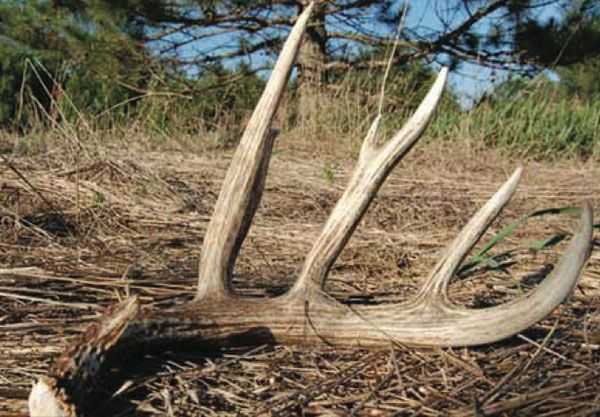Despite the fact that deer season ended on New Year’s Day, there’s still plenty of opportunity to wrap your hands around the antlers of a buck. No, I’m not advocating the breaking of any game laws. In fact, you won’t need so much as a slingshot to hunt them now. Each year, as the deer’s rutting season ends, a buck’s testosterone level makes a significant drop and triggers the shedding of his antlers. As surely as a new set will begin to grow in late spring, you can find the old ones with a just a little time and shoe leather.
Shed hunting is fast becoming one of the most popular winter pastimes for hunters across the nation and for good reason. By collecting these cast-offs a lot can be learned about the deer that inhabit your hunting grounds. Antlers found can be both a fair indicator of the age class of your bucks and let you know the quality of deer that survived the hunting season. Adding these findings to other efforts, such as year ‘round trail camera use and harvest records, can give you everything that you need to know to come up with a good management plan on your property.
Although a simple stroll through the woods can produce the occasional shed, there are more productive methods. First, don’t expect to see an entire antler lying in front of you. Many times only the tip of a point may be visible above the ground cover. Remember to approach the task as if you really are deer hunting. Locate good food sources and bedding areas then walk the many deer trails that will be between them. Deer are creatures of habit and utilize the same paths most every day. Thus, it only makes sense that these would be great places to find a shed. Creek crossings, fence lines and downed trees that cross the trails are also good places to look due to the fact that deer often jump them. Sometimes this jump is just enough to make the antler detach at that spot.
The real challenge is to find a matching set. If you find one side, don’t be too quick to continue on. Often times a buck will lose both antlers within a short distance of each other. Try walking a 50 to 100 yard grid pattern around the spot and you may get lucky.
In some states, shed hunting has become so big that hunters have devised “shed traps” and are even utilizing trained dogs to locate them. The traps are nothing more than three poles with chicken wire that are driven into the ground to simulate a fence corner. Once they are strategically placed, corn or deer feed is placed into the corner. As a buck comes in to the bait, his antlers are caught in the wire resulting in their detachment. Sadly, this is not a perfect method as many have been caught in the wire before their antlers were ready to turn loose. This meant that they likely ended up as an easy meal for coyotes or other predators.
It’s pretty common for hunt clubs throughout the mid-west to hold shed collecting days after season’s end. For obvious reasons, this is one of the most productive ways of finding sheds since more eyes in the woods guarantees a better success rate. Though this hasn’t become very common in the south, it doesn’t mean that you can’t take the same approach. Grab the kids or get your friends involved and you’re sure to come across a lot more antlers as well. Once you’ve found some and obtained all of the information that you need from them, such as age estimation, you can then utilize them for a number of neat craft projects. I’ve seen them used for door and cabinet handles, candlesticks, table lamps, bookends and a thousand other things. I even carry a keychain that was made from an antler tip by a friend of mine in Florida.
Just remember that, whether you find them or not, it’s all about having fun. But, you better hurry! Those racks are full of calcium and squirrels and other rodents love to chew them up. The later in the year that they are found, the more likely they are to have nothing more than a lot of little teeth marks where points used to be.
Good luck and happy hunting!
[easy-social-share]
